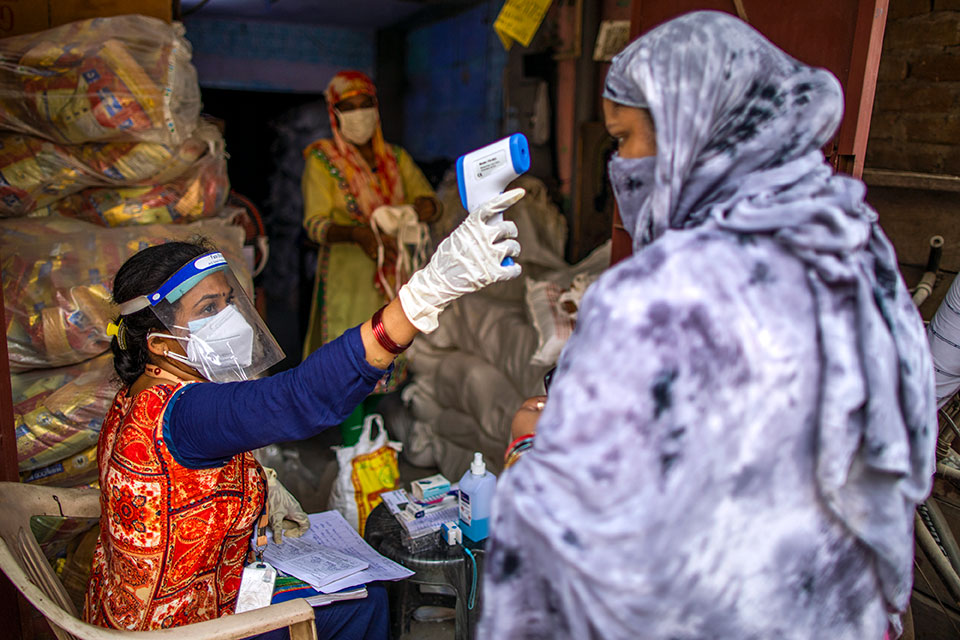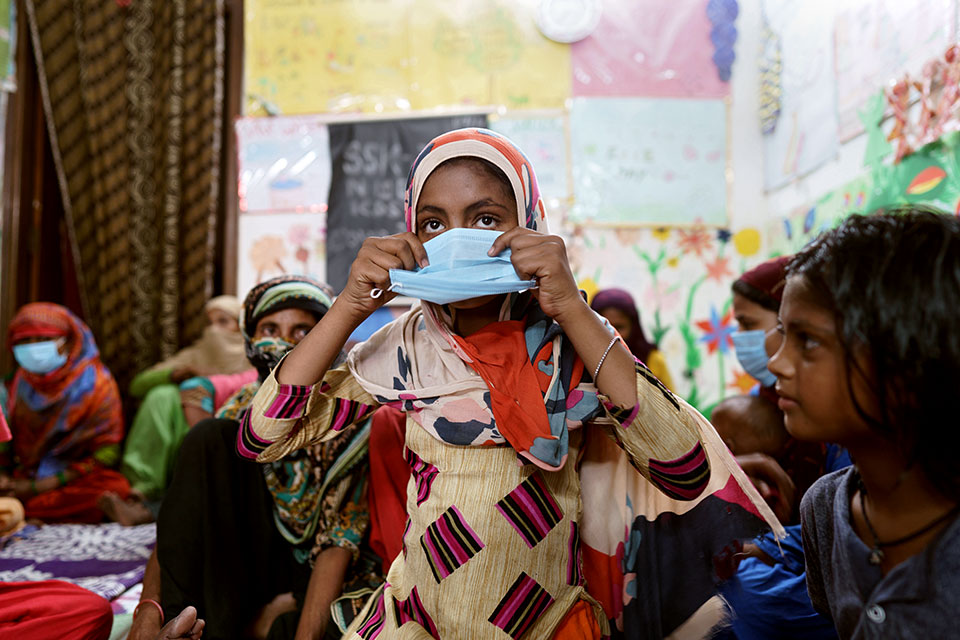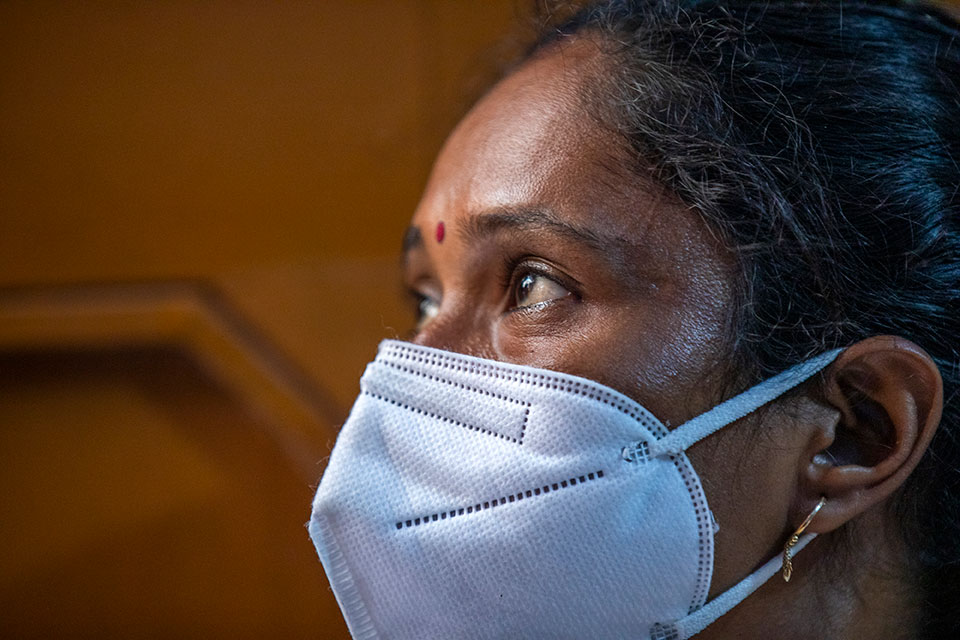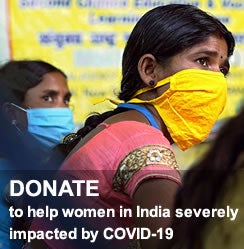Your questions answered: Women and COVID-19 in India
Date:

The second wave of COVID-19 in India brought unprecedented losses. The poorest and the most marginalized, including women and girls, face more risks without the means to absorb the economic shocks and mitigate the health crisis. They are caring for their families, sustaining livelihoods and leading efforts to fight the pandemic, amidst the threat of a third wave.
UN Women and health sector experts answer some frequently asked questions about COVID-19 and how it impacts women and girls in India.
Are women and girls at more risk of contracting COVID-19 than men?
Over 30 million people have been infected by the coronavirus in India. COVID-19 can infect people of all gender and ages. However, some women and girls may be at higher risk because they are poorer and lack information and resources, or because they are at the front line as caregivers and workers in the health and service sectors.
In India, women make up a significant proportion of all healthcare workers and more than 80 per cent of nurses and midwives. Yet, when it comes to decision-making roles in the health sector, they are largely absent, and they get paid much less than their male counterparts. Only 13 per cent of the members of the national COVID-19 task force are women.
Since women in India spend more hours caring for children, the elderly and sick family members, and masks and other personal protective equipment are often designed and sized for men, women may be at risk of more exposure to the virus.
Right now, there is also a concern that less women are getting vaccinated than men in India – 17 per cent more men than women have been partially or fully vaccinated, and according to national data, there are only two states where more women are taking the vaccine. Because of the fact that women have less access to internet or smart phones, they may not be able to register for vaccination. Due to the prevailing patriarchal norms, women may find it difficult to go to the vaccination centres alone, and there may be preference for male family members to get vaccinated first. There are also myths that vaccines compromise women’s fertility. Unvaccinated women are at a high risk of contracting the disease, especially in the wake of the new variants.
How has COVID-19 impacted women’s employment in India?
Wage inequality and the burden of unpaid care has pushed more women out of employment and into poverty. Women’s earned income in India was just one-fifth that of men’s even before the pandemic. Globally, and in India, more women have lost jobs during COVID-19. A recent report by the Center for Sustainable Employment at Azim Premji University in India shows that during the first lockdown in 2020, only 7 per cent of men lost their jobs, compared to 47 per cent of women who lost their jobs and did not return to work by the end of the year. In the informal sector, women fared even worse. This year, between March and April 2021, rural Indian women in informal jobs accounted for 80 per cent of job losses.
Indian women also spend more time doing unpaid care work at home than men. On an average, they spend 9.8 times more time than men on unpaid domestic chores and 4.5 hours a day caring for children, elders and the sick. During the pandemic, their share of unpaid care work grew by nearly 30 per cent.
The socio-economic toll on women and girls have long-term consequences, unless policies and actions deliberately target and invest in women. There is a risk that the exodus of women from the workforce could become permanent, reversing not only gender equality gains, but GDP gains. UN Women data [1] also shows that more girls than boys were left out of school during the pandemic and 65 per cent of parents surveyed were reluctant to continue the education of girls and resorting to child marriages to save costs. This can create an entire generation of young women without education and employment opportunities.

Has COVID-19 increased violence against women in India?
As the COVID-19 lockdowns trapped women at home with their abusers, domestic violence rates spiked throughout the world. In India, reports of domestic violence, child marriage, cyber violence and trafficking of women and girls increased within the first few months of the pandemic. According to the National Commission of Women data, India recorded a 2.5 times increase in domestic violence between February and May 2020. Some women’s organizations reported that in the first four phases of the lockdown, they received more reports of domestic violence than they had in the last ten years for a similar period of time. Others indicated that many women were unable to report the violence, as they had less privacy and means to access help.
The Indian Government classified domestic violence shelter and support services as “essential” – an important step in COVID-19 response. During the first and second waves of the pandemic, 700 One-Stop-Crisis centres remained open in India, supporting over 300,000 women who suffered abuse and needed shelter, legal aid and medical attention.
The current draft of the anti-trafficking bill that will be tabled soon in the Parliament is another welcome step, as it is set to increase penalties for perpetrators and make reporting of such crimes mandatory.
Should those who have recovered from COVID-19 not get vaccinated?
India has fully vaccinated 6.2 per cent of its population (as of 19 July 2021) and 17 per cent of its population has received at least one dose of COVID-19 vaccine. However, the vaccination rate has been declining and currently averaging at around 4 million doses daily.
Leading health organizations around the world have confirmed that people who have recovered from COVID-19 can still get re-infected. There is not enough data available to say if and how long a body’s natural immunity acquired after surviving the disease will last or protect against other variants. Therefore, those who have recovered from COVID-19 should still get vaccinated.
Getting vaccinated is also likely to protect people from getting severely sick from the virus, including the highly infectious variants.

Is the COVID-19 vaccine safe for pregnant or menstruating women?
There is no evidence yet about COVID-19 vaccines causing harmful side effects in menstruating, pregnant or lactating women. There is also no evidence that COVID-19 vaccines cause fertility problems. In fact, there is a higher risk of severe symptoms of COVID-19 if contracted during pregnancy.
WHO has also confirmed that women who are breastfeeding can safely take the vaccine and transmission of active COVID-19 disease-causing virus through breast milk has not been detected. There is evidence that vaccinating lactating mothers provides some protection to babies as the anti-bodies are passed on from mother to child.
For more information on COVID-19 prevention, safety and vaccination, please refer to the WHO website
How can we support women and girls in India during the COVID-19 crisis?
Every crisis impacts women and girls differently than men, because of existing gender norms and inequalities. To build back better and equal from the COVID-19 crisis, policy, investment and action must be shaped by women and girls and deliberately target them.
UN Women is working with the government and grassroots organizations on the ground to provide food, personal protective equipment for women, and cash assistance.
Through our communications campaigns, we are making sure that women get verified information about disease prevention and vaccination, and creating public awareness about gender-based violence. Through our programmes, we are making education and vocational training available for women through digital and distance learning, and helping them find pathways to employment and small businesses. We are working with our national partners to provide shelter, financial and legal assistance and medical help to survivors of gender-based violence in COVID-safe spaces.
UN Women is advocating with the government and private sector allies to invest in the formal and informal care economies to create sustainable jobs and boost women’s empowerment and income.
With your help, we can do much more. Donate to support women in South Asia today.
Notes
[1] UN Women survey conducted in 2020 in 14 states and 10 urban areas of India as part of a forthcoming report.
